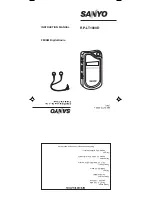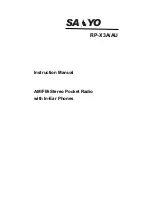
PRELIMINARY
•
Institute of Electrical and Electronic Engineers (IEEE) C95. 1-1999 Edition
•
International Commission on Non-Ionizing Radiation Protection (ICNIRP) 1998
•
Ministry of Health (Canada) Safety Code 6. Limits of Human Exposure to Radio frequency
Electromagnetic Fields in the Frequency Range from 3kHz to 300GHz, 1999
•
Australian Communications Authority Radio communications (Electromagnetic
Radiation-Human Exposure) Standard 1999 (applicable to wireless phones only)
Operational Instructions and Training Guidelines
To ensure optimal performance and compliance with the occupational/controlled environment RF
energy exposure limits in the above standards and guidelines, users should transmit no more than
50% of the time and always adhere to the following procedures:
Transmit and Receive
To transmit (talk), push the Push-To-Talk (PTT) button; to receive, release the PTT button.
Hand-held radio operation
Hold the radio in a vertical position with the microphone one to two inches (2.5 to 5 cm) away
from the lips.
Body-worn operation
•
Always place the radio in a RELM approved clip, holder, holster, case, or body harness for this
product. Use of non-RELM-approved accessories may exceed FCC RF exposure guidelines.
•
If you do not use a RELM approved body-worn accessory and are not using the radio in the
intended use position in front of the face, then ensure the antenna and the radio are kept 2.5 cm
(one inch) from the body when transmitting.
Antennas & Batteries
•
Use only RELM approved, supplied antenna or RELM approved replacement antenna.
Unauthorized antennas; modifications, or attachments could damage the radio and may violate
FCC regulations.
•
Use only RELM approved, supplied batteries or RELM approved replacement batteries. Use
of non-RELM-approved batteries may exceed FCC RF exposure guidelines.
Approved Accessories
For a list of RELM approved accessories see the accessories page of this user manual or visit the
following website which lists approved accessories: http://www.RELM.com
FCC Compliance
This equipment has been tested and found to comply with the limits for a Class B digital device,
pursuant to part 15 of the FCC Rules. These limits are designed to provide reasonable protection
against harmful interference in a residential installation. This equipment generates, uses and can
radiate radio frequency energy and, if not installed and used in accordance with the instructions,
may cause harmful interference to radio communications. However, there is no guarantee that
interference will not occur in a particular installation. If this equipment does cause harmful
interference to radio or television reception, which can be determined by turning the equipment
off and on, the user is encouraged to try to correct the interference by one or more of the
following measures:
•
Reorient or relocate the receiving antenna.
•
Increase the separation between the equipment and receiver.
•
Connect the equipment into an outlet on a circuit different from that to which the receiver is



































